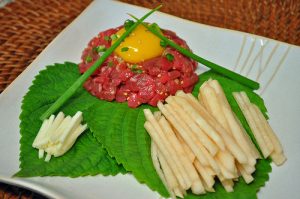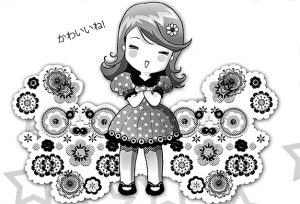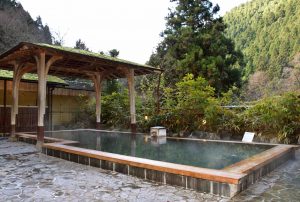In June 1996, initial reports of an outbreak of E. coli O157:H7 in Japan surfaced in national media.
 By July 1996, focus had centered on specific school cafeterias and two vendors of box lunches, as the number of illnesses approached 4,000. Lunches of sea eel sushi and soup distributed on July 5 from Sakai’s central school lunch depot were identified by health authorities as a possible source of one outbreak. The next day, the number of illnesses had increased to 7,400 even as reports of Japanese fastidiousness intensified. By July 23, 1996, 8,500 were listed as ill.
By July 1996, focus had centered on specific school cafeterias and two vendors of box lunches, as the number of illnesses approached 4,000. Lunches of sea eel sushi and soup distributed on July 5 from Sakai’s central school lunch depot were identified by health authorities as a possible source of one outbreak. The next day, the number of illnesses had increased to 7,400 even as reports of Japanese fastidiousness intensified. By July 23, 1996, 8,500 were listed as ill.
Even though radish sprouts were ultimately implicated — and then publicly cleared in a fall-on-sword ceremony, but not by the U.S. — the Health and Welfare Ministry announced that Japan’s 333 slaughterhouses must adopt a quality control program modeled on U.S. safety procedures, requiring companies to keep records so the source of any tainted food could be quickly identified. Kunio Morita, chief of the ministry’s veterinary sanitation division was quoted as saying “It’s high time for Japan to follow the international trend in sanitation management standards.”
Japanese health authorities were terribly slow to respond to the outbreak of E. coli O157:H7, a standard facilitated by a journalistic culture of aversion rather than adversarial. In all, over 9,500 Japanese, largely schoolchildren, were stricken with E. coli O157:H7 and 12 were killed over the summer of 1996, raising questions of political accountability.
The national Mainichi newspaper demanded in an editorial on July 31, 1996, “Why can’t the government learn from past experience? Why were they slow to react to the outbreak? Why can’t they take broader measures?” The answer, it said, was a “chronic ailment” — the absence of anyone in the government to take charge in a crisis and ensure a coordinated response. An editorial cartoon in the daily Asahi Evening News showed a health worker wearing the label “government emergency response” riding to the rescue on a snail. Some of the victims have filed lawsuits against Japanese authorities, a move previously unheard of in the Japanese culture of deference.
Fifteen years later, with at least four dead and 100 sick from E. coli O111 served in raw beef at the Yakiniku-zakaya Ebisu barbecue restaurant chain, Japanese corporate, political and media leaders are still struggling.
Anrakutei Co., a Saitama-based yakiniku barbecue chain, stopped serving yukke at its 250 outlets, mainly in the Kanto region, on Tuesday.
“We’ve been providing the dish to customers based on strict quality control, but customers’ concerns make it difficult to continue to serve it,” a public relations official of the company said.
 Anrakutei said the company conducts bacteria tests on the Australian beef it uses for yukke three times–first before it is purchased, again before it is sent to the company’s meat processing plant and finally before it is shipped to outlets. At the plant, the meat is processed separately from other food materials to prevent it from coming into contact with bacteria, the company explained.
Anrakutei said the company conducts bacteria tests on the Australian beef it uses for yukke three times–first before it is purchased, again before it is sent to the company’s meat processing plant and finally before it is shipped to outlets. At the plant, the meat is processed separately from other food materials to prevent it from coming into contact with bacteria, the company explained.
There is no discussion of what is being tested, and how valid those tests are at picking up a non-O157 shiga-toxin producing E. coli like O111 There is no verification that anyone is testing anything.
In the absence of meat goggles that can magically detect dangerous bacteria, eating raw hamburger remains a risk.
Today, the Tokyo District Court ordered restaurant chain operator Foods Forus Co. to pay ¥169 million ($1.58 million) to the families of three victims who died from food poisoning after eating raw meat at one of its barbecue restaurants in 2011.
While the court awarded damages to the plaintiffs, it ruled that the former president of Foods Forus, which is filing for special liquidation, was not guilty of gross negligence. The plaintiffs had sought around ¥209 million in damages and medical treatment expenses from the company and the former president.
Around 180 customers developed symptoms of food poisoning after dining at six Yakiniku-zakaya Ebisu restaurants in four prefectures — Kanagawa, Toyama, Ishikawa, and Fukui — in April 2011. A strain of E. coli, O-111, was found in many of the victims.
Five died due to illness. Nine plaintiffs, including the families of three who died after eating at the outlet in Tonami, Toyama Prefecture, sued the company and the former president in October 2014.
In February 2016, police investigated the former president on suspicion of professional negligence resulting in death or injury and sent the case to prosecutors. But the prosecutors decided not to indict him.
The families of the victims are considering filing a petition with a prosecution inquest panel in a bid to overturn the decision.
 A woman in southwestern Japan suffered symptoms of food poisoning, including acute pain in her mouth, after mistakenly eating night-scented lily, the prefectural government announced on Nov. 26.
A woman in southwestern Japan suffered symptoms of food poisoning, including acute pain in her mouth, after mistakenly eating night-scented lily, the prefectural government announced on Nov. 26.








